Sintering Temperature Effect of Near-Zero Thermal Expansion Mn3Zn0.8Sn0.2N/Ti Composites
Abstract
:1. Introduction
2. Materials and Methods
3. Results and Discussion
3.1. Reinforcement Characterization
3.2. Phase Composition and Microstructure
3.3. Thermal Expansion
3.4. Mechanical Properties
4. Conclusions
- Mn3Zn0.8Sn0.2N exhibits excellent negative thermal expansion performance, with a thermal expansion coefficient of −56.4 ppm/K in the range of −45 °C to −5 °C;
- Mn3Zn0.8Sn0.2N/Ti composites prepared at 700 °C demonstrate high density and low reactivity;
- The Mn3Zn0.8Sn0.2N/Ti composite fabricated at 700 °C exhibits excellent comprehensive performance with near-zero thermal expansion in the range of −55 °C to −24 °C (−3.22 ppm/K) and a bending strength of 253 MPa;
- Finite element analysis indicates significant thermal mismatch stress within the composites. This could influence the performance of Mn3Zn0.8Sn0.2N particles, leading to a displacement of the near-zero expansion temperature range within the composites compared to individual Mn3Zn0.8Sn0.2N particles.
Author Contributions
Funding
Institutional Review Board Statement
Informed Consent Statement
Data Availability Statement
Conflicts of Interest
References
- Li, Q.; Lin, K.; Liu, Z.N.; Hu, L.; Cao, Y.L.; Chen, J.; Xing, X.R. Chemical Diversity for Tailoring Negative Thermal Expansion. Chem. Rev. 2022, 122, 8438–8486. [Google Scholar] [CrossRef]
- Zhou, H.; Tao, K.; Chen, B.; Chen, H.D.; Qiao, K.M.; Yu, Z.Y.; Cong, J.Z.; Huang, R.J.; Taskaev, S.V.; Zhang, H. Low-melting metal bonded MM′X/In composite with largely enhanced mechanical property and anisotropic negative thermal expansion. Acta Mater. 2022, 229, 117830. [Google Scholar] [CrossRef]
- Cao, H.; Su, Y.S.; Zhang, D.; Ouyang, Q.B. Fabrication, mechanical and thermal behaviors of antiperovskite manganese nitride Mn3.1Zn0.5Sn0.4N reinforced aluminum matrix composites. Compos. Part B-Eng. 2021, 223, 109080. [Google Scholar] [CrossRef]
- Li, X.; Fang, L.M.; Chen, B.; He, D.W. High-pressure and high-temperature synthesis and study of the thermal properties of ZrW2O8/Cu composites. Physica B 2016, 487, 37–41. [Google Scholar] [CrossRef]
- Attfield, J.P. Mechanisms and Materials for NTE. Front. Chem. 2018, 6, 371. [Google Scholar] [CrossRef]
- Fedorova, A.; Kampf, T.; Scheffler, M. Study of Phase Decomposition in ZrW2O8. Adv. Eng. Mater. 2016, 18, 1118–1122. [Google Scholar] [CrossRef]
- Shen, C.; Chen, X.Y. Analysis and modeling for fiber-optic gyroscope scale factor based on environment temperature. Appl. Opt. 2012, 51, 2541–2547. [Google Scholar] [CrossRef] [PubMed]
- Hu, F.X.; Shen, F.R.; Hao, J.Z.; Liu, Y.; Wang, J.; Sun, J.R.; Shen, B.G. Negative Thermal Expansion in the Materials With Giant Magnetocaloric Effect. Front. Chem. 2018, 6, 438. [Google Scholar] [CrossRef] [PubMed]
- Wang, Y.G.; Zhang, H.; Zhu, J.L.; Lu, X.J.; Li, S.; Zou, R.Q.; Zhao, Y.S. Antiperovskites with Exceptional Functionalities. Adv. Mater. 2020, 32, 1905007. [Google Scholar] [CrossRef] [PubMed]
- Cao, H.; Su, Y.S.; Cui, D.; Zhang, D.; Ouyang, Q.B. Microstructural characterization, mechanical properties and thermal expansion of antiperovskite manganese nitride Mn3.1Zn0.5Sn0.4N fabricated by combing vacuum sintering and spark-plasma sintering. Mater. Charact. 2020, 160, 110100. [Google Scholar] [CrossRef]
- Yan, X.H.; Miao, J.J.; Liu, J.Q.; Wu, X.; Zou, H.; Sha, D.W.; Ren, J.; Dai, Y.; Wang, J.J.; Cheng, X.N. Zero thermal expansion, electrical conductivity and hardness of Mn3Zn0.5Sn0.5N/Cu composites. J. Alloys Compd. 2016, 677, 52–56. [Google Scholar] [CrossRef]
- Hamada, T.; Takenaka, K. Giant negative thermal expansion in antiperovskite manganese nitrides. J. Appl. Phys. 2011, 109, 07e309. [Google Scholar] [CrossRef]
- Ding, L.; Wang, C.; Na, Y.; Chu, L.; Yan, J. Preparation and near zero thermal expansion property of Mn3Cu0.5A0.5N (A=Ni, Sn)/Cu composites. Scr. Mater. 2011, 65, 687–690. [Google Scholar] [CrossRef]
- Shi, K.W.; Sun, Y.; Colin, C.V.; Wang, L.; Yan, J.; Deng, S.H.; Lu, H.Q.; Zhao, W.J.; Kazunari, Y.; Bordet, P.; et al. Investigation of the spin-lattice coupling in Mn3Ga1-xSnxN antiperovskites. Phys. Rev. B 2018, 97, 054110. [Google Scholar] [CrossRef]
- Zhou, Y.X.; Zhou, C.; Wang, Z.J.; Wu, Y.M.; Zhang, Q.; Qiao, J.; Wu, G.H. The effect of interface reaction on the thermal and mechanical properties of Mn3.2Zn0.5Sn0.3N/Al composites. Ceram. Int. 2022, 48, 25826–25832. [Google Scholar] [CrossRef]
- Yan, J.; Sun, Y.; Wang, C.; Chu, L.H.; Shi, Z.X.; Deng, S.H.; Shi, K.W.; Lu, H.Q. Study of structure of Mn3Cu0.5Ge0.5N/Cu composite with nearly zero thermal expansion behavior around room temperature. Scr. Mater. 2014, 84–85, 19–22. [Google Scholar] [CrossRef]
- Shan, X.R.; Huang, R.J.; Han, Y.M.; Huang, C.J.; Liu, X.P.; Lu, Z.G.; Li, L.F. La(Fe, Si, Co)13/Cu conductive composites with tailoring thermal expansion. J. Alloys Compd. 2016, 662, 505–509. [Google Scholar] [CrossRef]
- Qiao, Y.Q.; Xiao, N.; Song, Y.Z.; Deng, S.Q.; Huang, R.J.; Li, L.F.; Xing, X.R.; Chen, J. Achieving High Performances of Ultra-Low Thermal Expansion and High Thermal Conductivity in 0.5PbTiO3-0.5(Bi0.9La0.1)FeO3@Cu Core-Shell Composite. ACS Appl. Mater. Interfaces 2020, 12, 57228–57234. [Google Scholar] [CrossRef] [PubMed]
- Zhou, C.; Zhou, Y.X.; Liu, S.Y.; Zhang, L.Y.; Song, P.Y.; Zhang, Q.; Ma, B.Y.; Wu, G.H. Lightweight and near-zero thermal expansion ZrW2O8-SiCnw/Al hybrid composites. J. Alloys Compd. 2022, 907, 164444. [Google Scholar] [CrossRef]
- Zhou, C.; Zhou, Y.X.; Zhang, Q.; Meng, Q.Y.; Zhang, L.Y.; Kobayashi, E.; Wu, G.H. Near-zero thermal expansion of ZrW2O8/Al-Si composites with three dimensional interpenetrating network structure. Compos. Part B-Eng. 2021, 211, 108678. [Google Scholar] [CrossRef]
- Takenaka, K.; Hamada, T.; Kasugai, D.; Sugimoto, N. Tailoring thermal expansion in metal matrix composites blended by antiperovskite manganese nitrides exhibiting giant negative thermal expansion. J. Appl. Phys. 2012, 112, 083517. [Google Scholar] [CrossRef]
- Handtrack, D.; Despang, F.; Sauer, C.; Kieback, B.; Reinfried, N.; Grin, Y. Fabrication of ultra-fine grained and dispersion-strengthened titanium materials by spark plasma sintering. Mater. Sci. Eng. A-Struct. 2006, 437, 423–429. [Google Scholar] [CrossRef]
- Topolski, K.; Brynk, T.; Garbacz, H. Elastic modulus of nanocrystalline titanium evaluated by cyclic tensile method. Arch. Civ. Mech. Eng. 2016, 16, 927–934. [Google Scholar] [CrossRef]
- Takenaka, K.; Ichigo, M. Thermal expansion adjustable polymer matrix composites with giant negative thermal expansion filler. Compos. Sci. Technol. 2014, 104, 47–51. [Google Scholar] [CrossRef]
- Han, H.M.; Sun, Y.; Deng, S.H.; Shi, K.W.; Yuan, X.L.; Ren, J.; An, S.H.; Cui, J.; Hu, D.M.; Ma, Z.J.; et al. Effect of thermal stress on non-collinear antiferromagnetic phase transitions in antiperovskite Mn3GaN compounds with Mn3SbN inclusions. Ceram. Int. 2022, 48, 15200–15206. [Google Scholar] [CrossRef]
- Matsunami, D.; Fujita, A.; Takenaka, K.; Kano, M. Giant barocaloric effect enhanced by the frustration of the antiferromagnetic phase in Mn3GaN. Nat. Mater. 2015, 14, 73–78. [Google Scholar] [CrossRef]
- Wang, S.K.; Ge, B.Z.; Hu, J.B.; Xie, W.Q.; Liu, Y.; Xu, S.J.; Shi, Z.Q. Highly textured TiN ceramic prepared by edge-free spark plasma sintering. Mater. Sci. Technol. 2022, 38, 1029–1036. [Google Scholar] [CrossRef]
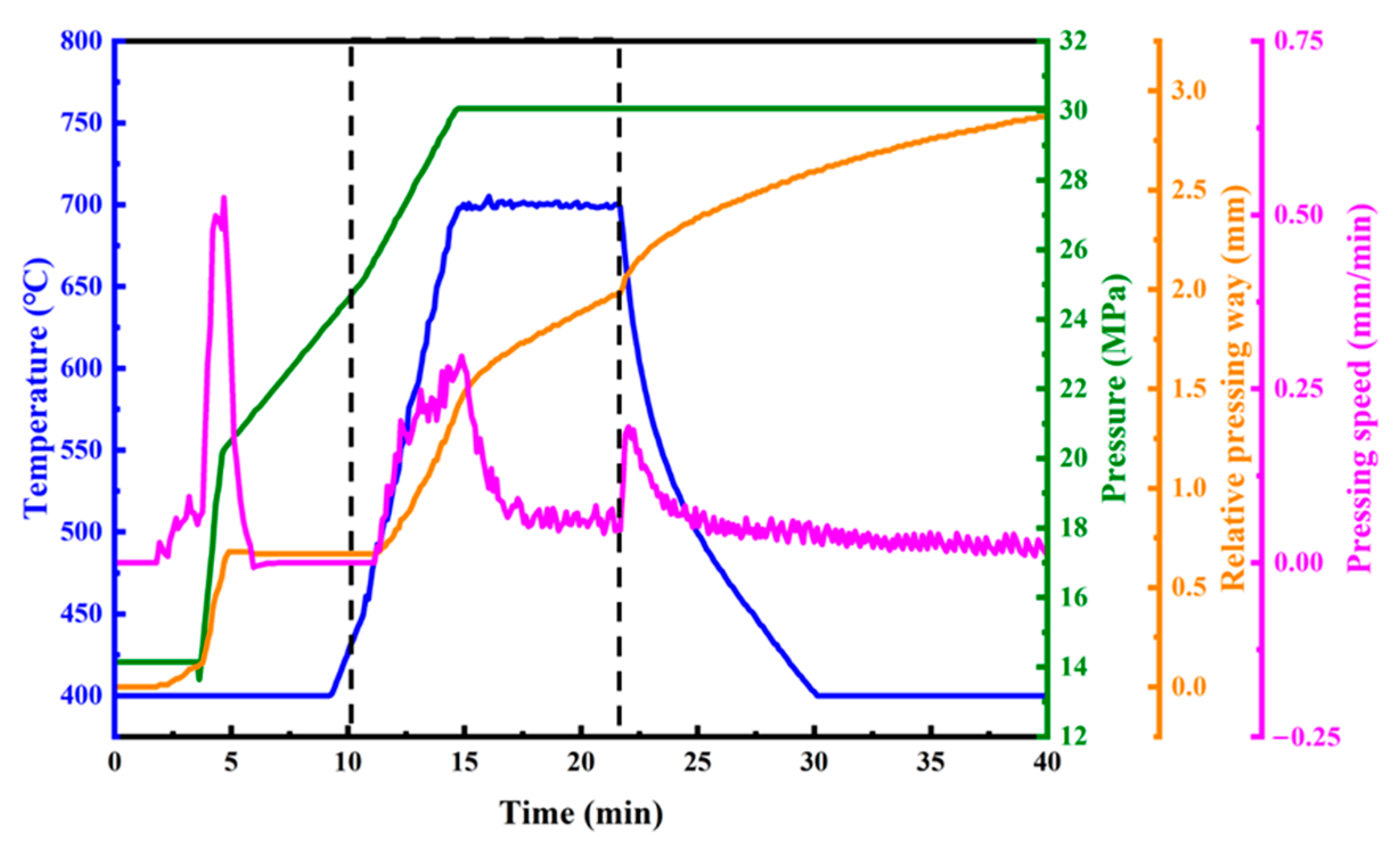

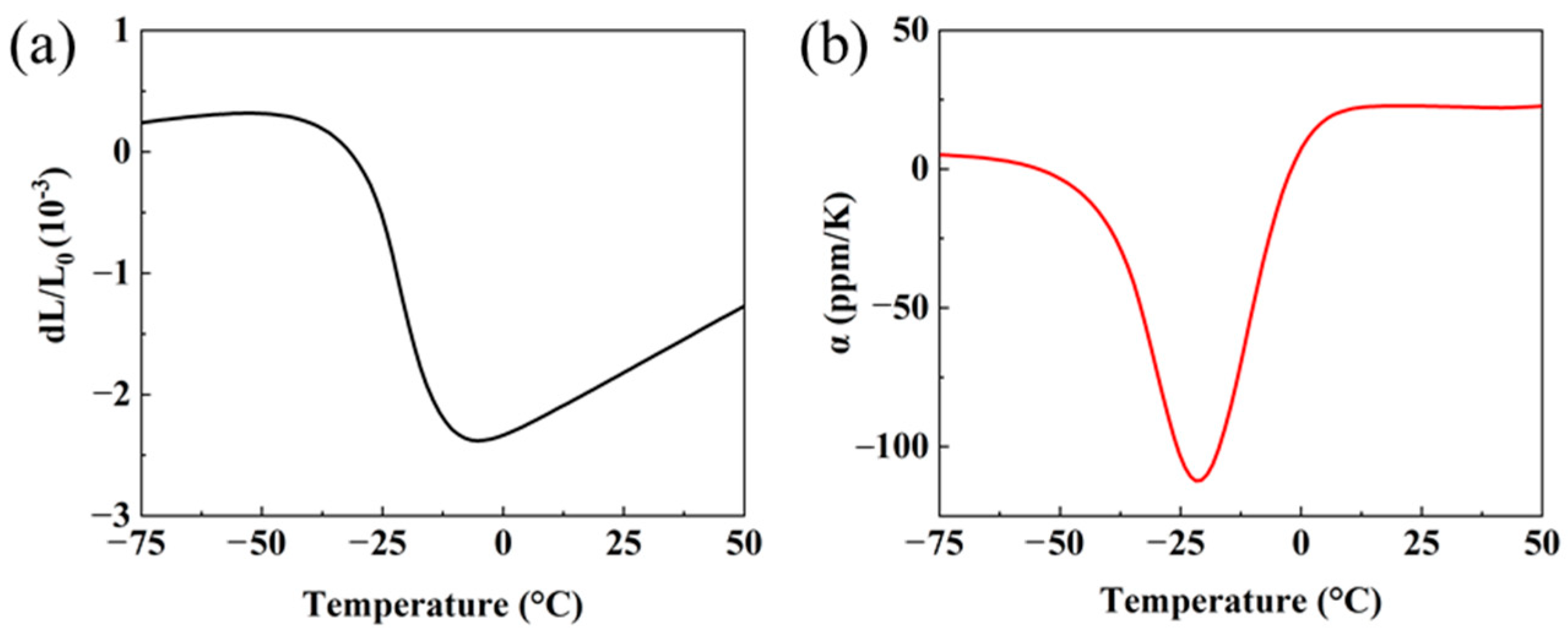



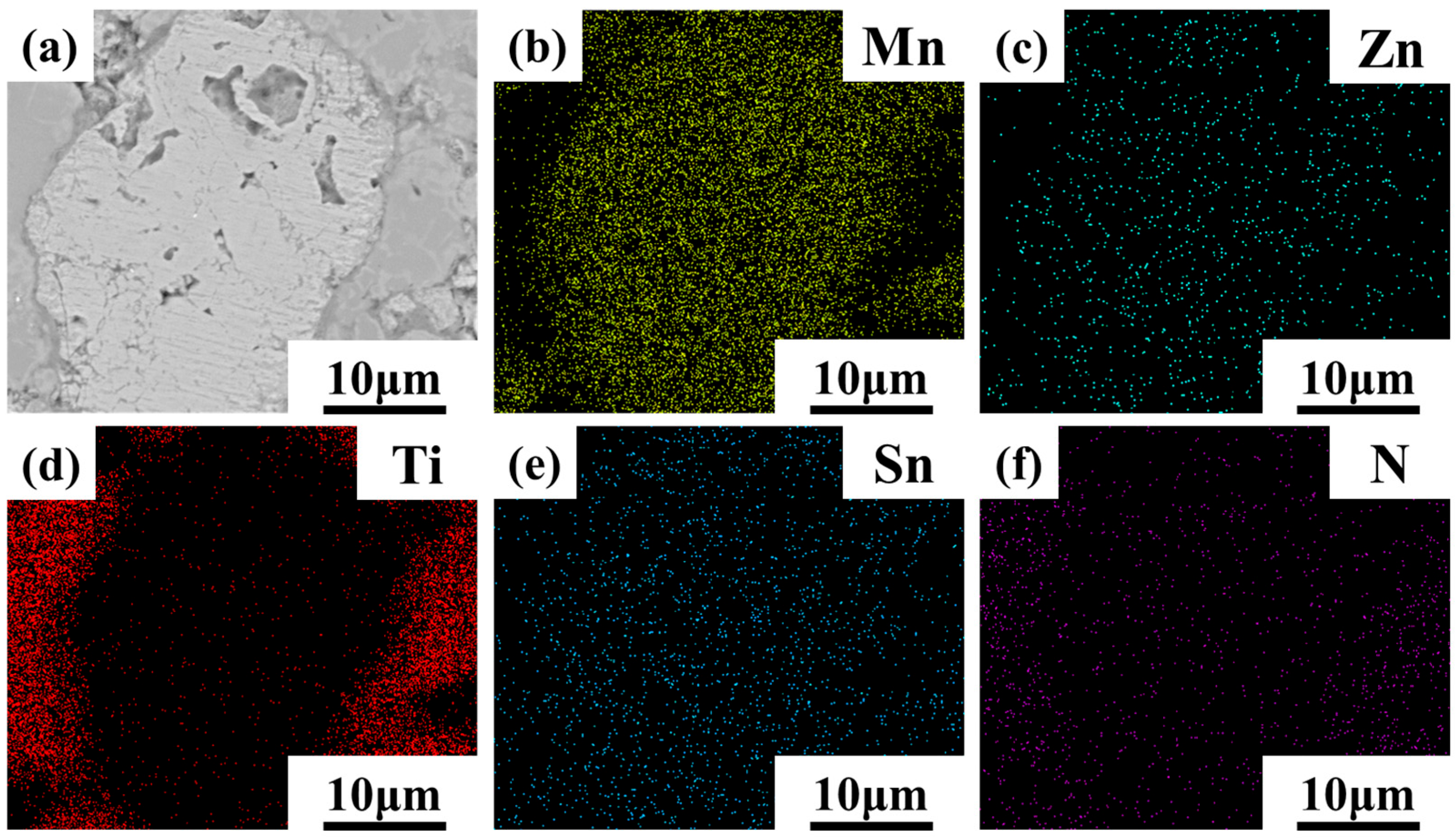
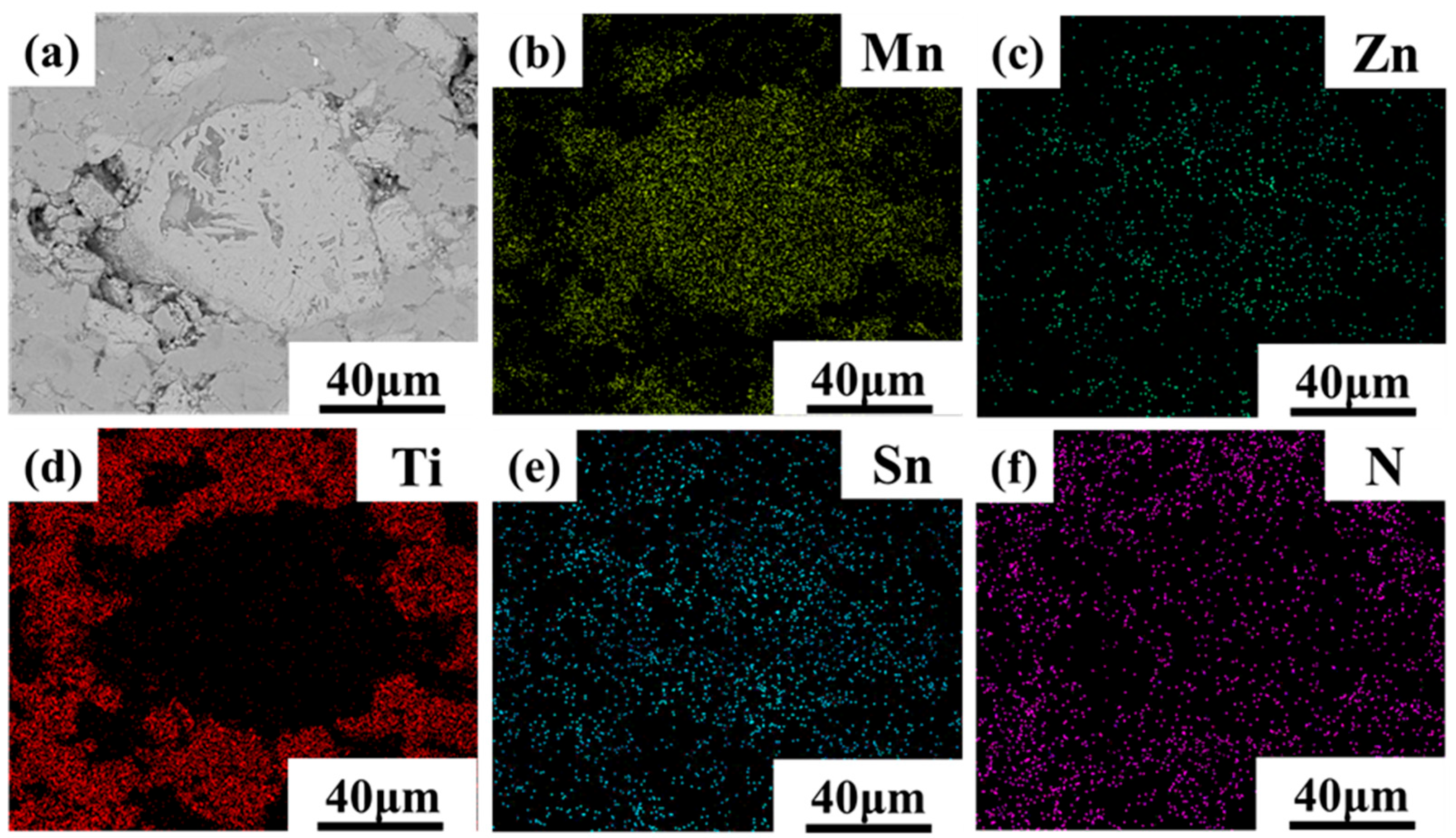
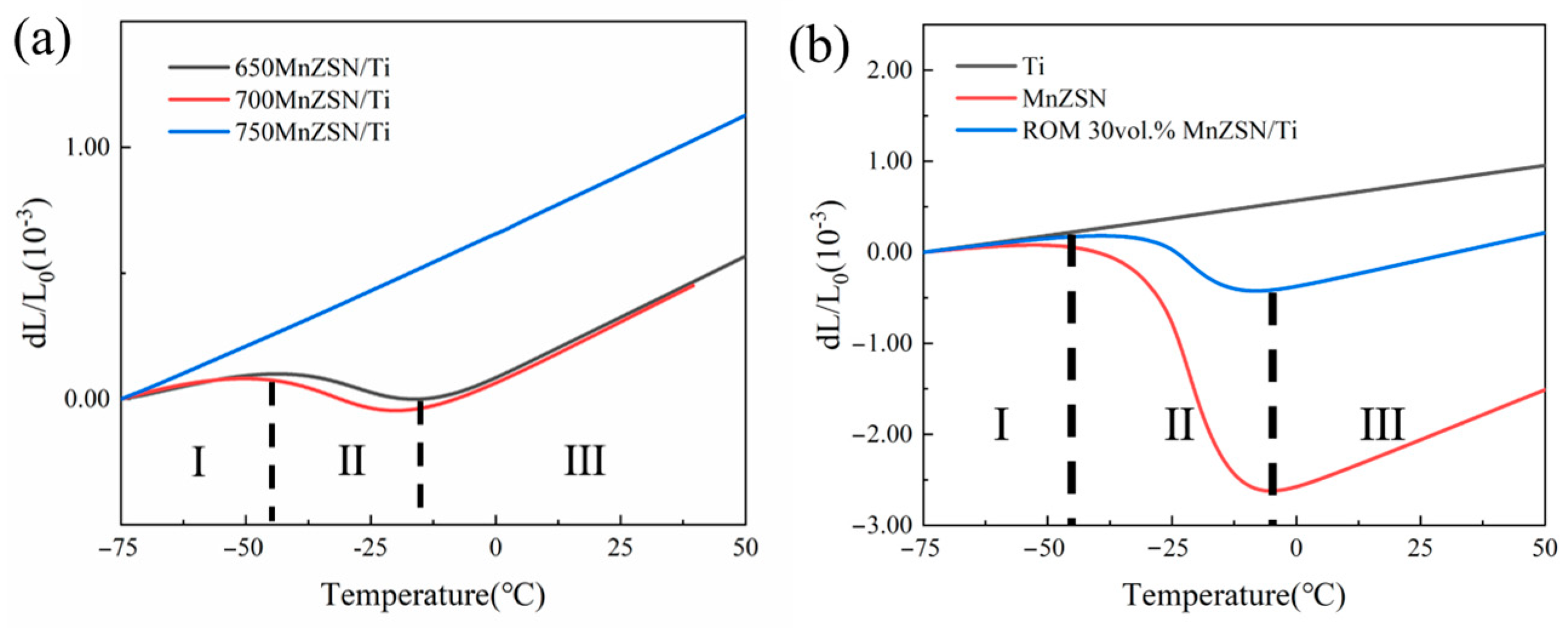

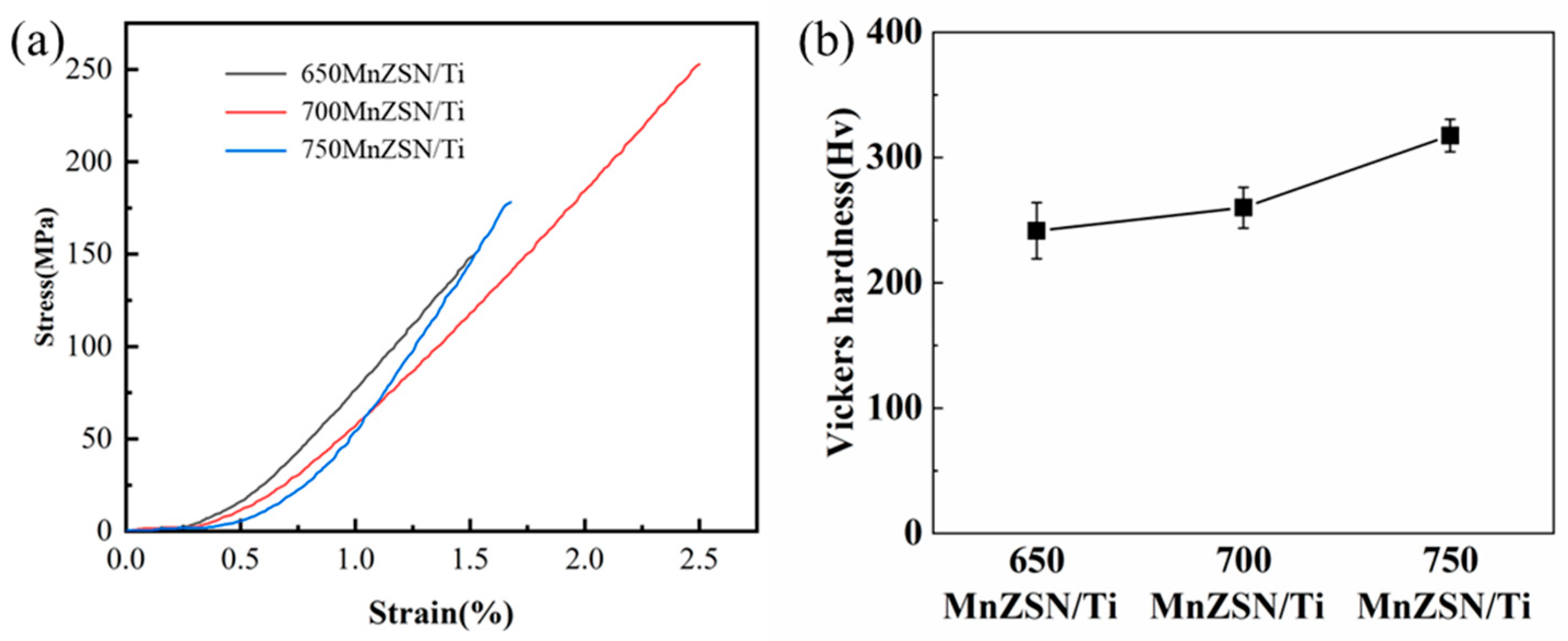

Disclaimer/Publisher’s Note: The statements, opinions and data contained in all publications are solely those of the individual author(s) and contributor(s) and not of MDPI and/or the editor(s). MDPI and/or the editor(s) disclaim responsibility for any injury to people or property resulting from any ideas, methods, instructions or products referred to in the content. |
© 2023 by the authors. Licensee MDPI, Basel, Switzerland. This article is an open access article distributed under the terms and conditions of the Creative Commons Attribution (CC BY) license (https://creativecommons.org/licenses/by/4.0/).
Share and Cite
Zhou, Y.; Zhang, L.; Qian, J.; Qian, Z.; Hao, B.; Cong, Q.; Zhou, C. Sintering Temperature Effect of Near-Zero Thermal Expansion Mn3Zn0.8Sn0.2N/Ti Composites. Materials 2023, 16, 5919. https://doi.org/10.3390/ma16175919
Zhou Y, Zhang L, Qian J, Qian Z, Hao B, Cong Q, Zhou C. Sintering Temperature Effect of Near-Zero Thermal Expansion Mn3Zn0.8Sn0.2N/Ti Composites. Materials. 2023; 16(17):5919. https://doi.org/10.3390/ma16175919
Chicago/Turabian StyleZhou, Yongxiao, Lianyu Zhang, Jinrui Qian, Zhiying Qian, Baoxin Hao, Qiang Cong, and Chang Zhou. 2023. "Sintering Temperature Effect of Near-Zero Thermal Expansion Mn3Zn0.8Sn0.2N/Ti Composites" Materials 16, no. 17: 5919. https://doi.org/10.3390/ma16175919
APA StyleZhou, Y., Zhang, L., Qian, J., Qian, Z., Hao, B., Cong, Q., & Zhou, C. (2023). Sintering Temperature Effect of Near-Zero Thermal Expansion Mn3Zn0.8Sn0.2N/Ti Composites. Materials, 16(17), 5919. https://doi.org/10.3390/ma16175919





